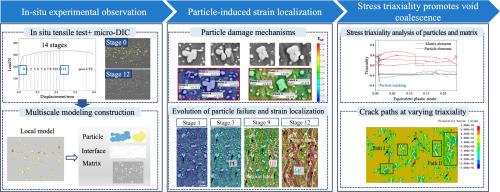In situ study of micro-damage evolution in 2195 aluminum alloy
IF 9.4
1区 工程技术
Q1 ENGINEERING, MECHANICAL
International Journal of Mechanical Sciences
Pub Date : 2025-09-18
DOI:10.1016/j.ijmecsci.2025.110848
引用次数: 0
Abstract
2195 aluminum alloy has emerged as a highly valuable aerospace material due to its exceptional strength-to-weight ratio. However, its limited ductility and crack susceptibility during room-temperature forming restrict wider application. To elucidate the underlying damage mechanisms, this study employed multi-stage in situ tensile experiments combined with microscopic digital image correlation (micro-DIC) to quantitatively analyze the damage mechanisms and evolution of second-phase particles with varying characteristics. Additionally, a finite element model based on actual microstructure and deformation boundary conditions was developed, enabling precise simulation of the deformation process. The experimental results indicate particle size significantly affects the failure strain, while particle shape governs the damage mechanisms. The strain localization induced by the fracture of irregular and coarse particles promotes the formation of localized deformation bands, thereby activating the damage mechanism of particle debonding. Simulation further reveals that post-yield stress concentration and elevated stress triaxiality within irregular particles trigger damage initiation. Subsequent matrix regions near fractured particles exhibit increased stress triaxiality, accelerating matrix degradation. Beyond the ultimate tensile strength, the substantial increase in shear stress caused by interface debonding facilitates the coalescence of voids along the strain bands. These findings provide mechanistic insights into particle-induced damage processes and offer predictive guidelines for enhancing the room-temperature formability of 2xxx series aluminum alloys.

2195铝合金微损伤演化的原位研究
2195铝合金因其特殊的强度重量比而成为一种非常有价值的航空航天材料。然而,其在室温成形时有限的延展性和裂纹敏感性限制了其广泛应用。为了阐明潜在的损伤机制,本研究采用多阶段原位拉伸实验结合微观数字图像相关(micro-DIC)技术,定量分析了不同特征的第二相颗粒的损伤机制和演化过程。此外,建立了基于实际微观结构和变形边界条件的有限元模型,实现了变形过程的精确模拟。实验结果表明,颗粒尺寸对破坏应变有显著影响,而颗粒形状对损伤机制有重要影响。不规则和粗颗粒断裂引起的应变局部化促进了局部变形带的形成,从而激活了颗粒脱粘的损伤机制。模拟进一步表明,屈服后应力集中和不规则颗粒内应力三轴性升高触发了损伤的发生。随后靠近断裂颗粒的基体区域表现出应力三轴性增加,加速了基体的降解。在极限抗拉强度之外,界面脱粘引起的剪切应力大幅增加,促进了沿应变带的空洞聚并。这些发现为颗粒诱导损伤过程提供了机理见解,并为提高2xxx系列铝合金的室温成形性提供了预测指南。
本文章由计算机程序翻译,如有差异,请以英文原文为准。
求助全文
约1分钟内获得全文
求助全文
来源期刊

International Journal of Mechanical Sciences
工程技术-工程:机械
CiteScore
12.80
自引率
17.80%
发文量
769
审稿时长
19 days
期刊介绍:
The International Journal of Mechanical Sciences (IJMS) serves as a global platform for the publication and dissemination of original research that contributes to a deeper scientific understanding of the fundamental disciplines within mechanical, civil, and material engineering.
The primary focus of IJMS is to showcase innovative and ground-breaking work that utilizes analytical and computational modeling techniques, such as Finite Element Method (FEM), Boundary Element Method (BEM), and mesh-free methods, among others. These modeling methods are applied to diverse fields including rigid-body mechanics (e.g., dynamics, vibration, stability), structural mechanics, metal forming, advanced materials (e.g., metals, composites, cellular, smart) behavior and applications, impact mechanics, strain localization, and other nonlinear effects (e.g., large deflections, plasticity, fracture).
Additionally, IJMS covers the realms of fluid mechanics (both external and internal flows), tribology, thermodynamics, and materials processing. These subjects collectively form the core of the journal's content.
In summary, IJMS provides a prestigious platform for researchers to present their original contributions, shedding light on analytical and computational modeling methods in various areas of mechanical engineering, as well as exploring the behavior and application of advanced materials, fluid mechanics, thermodynamics, and materials processing.
 求助内容:
求助内容: 应助结果提醒方式:
应助结果提醒方式:


